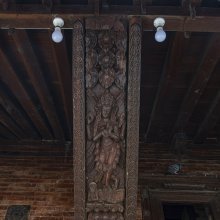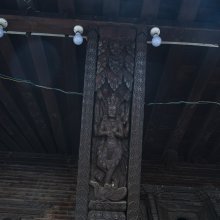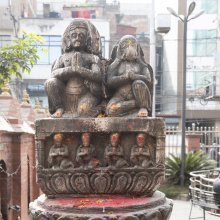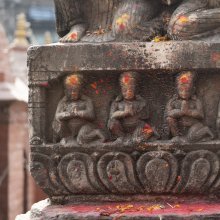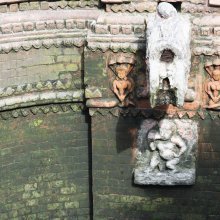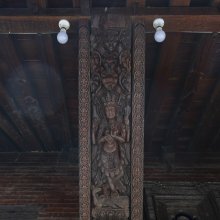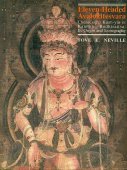Pagoda: 3 definitions
Introduction:
Pagoda means something in the history of ancient India, Hindi. If you want to know the exact meaning, history, etymology or English translation of this term then check out the descriptions on this page. Add your comment or reference to a book if you want to contribute to this summary article.
Images (photo gallery)
(+31 more images available)
India history and geography
Source: Cologne Digital Sanskrit Dictionaries: Indian Epigraphical GlossaryPagoda.—(EI 8-8), also called ‘star pagoda’; English name of the gold coin called hūn (hon) or varāha; probably so called because the coins often bore the representation of a temple called pagod or pagoda by the early European travellers. The word seems to have been derived from Sanskrit bhagavat or bhagavatī meaning the deities worshipped in the temples and also often figuring on the coins. Cf. ‘ṭaṅkakas stamped with the figure of the Bhagavat’ (Bhandarkar's List, No. 2033). Cf. Cīna-pagoda (SII 12), ‘the Chinese temple’; name of a Buddhist shrine at Nāgapaṭṭanam. Note: pagoda is defined in the “Indian epigraphical glossary” as it can be found on ancient inscriptions commonly written in Sanskrit, Prakrit or Dravidian languages.
See also (synonyms): Pagod.
--- OR ---
Pagoda.—also called ‘star pagoda’; Anglicised form of the name of the gold coin called gadyāṇa, hūn (hon) or varāha; since the word pagoda also meant ‘a temple’, the coin seems to have been so named owing to the representation of a temple or a deity on it; pagoda may be a corruption of bhagavatī meaning ‘the mother- goddess’. Note: pagoda is defined in the “Indian epigraphical glossary” as it can be found on ancient inscriptions commonly written in Sanskrit, Prakrit or Dravidian languages.

The history of India traces the identification of countries, villages, towns and other regions of India, as well as mythology, zoology, royal dynasties, rulers, tribes, local festivities and traditions and regional languages. Ancient India enjoyed religious freedom and encourages the path of Dharma, a concept common to Buddhism, Hinduism, and Jainism.
Languages of India and abroad
Hindi dictionary
Source: DDSA: A practical Hindi-English dictionaryPagoḍā (पगोडा):—(nm) a pagoda, Buddhist monastery.
...
Kannada-English dictionary
Source: Alar: Kannada-English corpusPagōḍa (ಪಗೋಡ):—
1) [noun] a temple usu. a pyramidlike tower and typically having upward-curving roofs over the individual stories, built over a sacred relic or as a work of devotion; a pagoda.
2) [noun] the tower of a building esp. a temple.
3) [noun] any of several former gold or silver coins of southern India, usu. bearing a figure of such a temple, first issued in the late 16th century.
Kannada is a Dravidian language (as opposed to the Indo-European language family) mainly spoken in the southwestern region of India.
See also (Relevant definitions)
Starts with: Pagoda dogwood, Pagoda flower, Pagoda tree, Pakota.
Ends with: Alpakota, Cina-pagoda, Pakota.
Full-text (+71): Hun, Stupa, Vriddhakala, Pagoda flower, Honamala, Japanese pagoda tree, Pagoda dogwood, Pakkuvata, Cetiyagabbha, Devalaya, Cetiya, Chattamangala, Cetiyangana, Pakkata, Varaya, Devula, Pagoda tree, Bolihona, Varai, Vhana.
Relevant text
Search found 46 books and stories containing Pagoda, Pagoḍā, Pagōḍa; (plurals include: Pagodas, Pagoḍās, Pagōḍas). You can also click to the full overview containing English textual excerpts. Below are direct links for the most relevant articles:
The Way of the White Clouds (by Anāgarika Lāma Govinda)
Chapter 27 - U Khanti, the Seer of Mandalay Hill < [Part 3 - Death and Rebirth]
Chapter 28 - Maung Tun Kyaing < [Part 3 - Death and Rebirth]
Chapter 41 - The Sacred Mountain < [Part 4 - Return to Western Tibet]
The travels of Fa-Hian (400 A.D.) (by Samuel Beal)
Chaitanya's Life and Teachings (by Krishna-das Kaviraj)
Abhidhamma in Daily Life (by Ashin Janakabhivamsa) (by Ashin Janakabhivamsa)
Part 3 - Importance Of The Last Minute < [Chapter 8 - What happen when death draws near (mind processes immediately preceding death)]
Domain 1 - Dana (charity) < [Chapter 6 - Ten domains of meritorious actions (ten punna kiriyavatthu)]
Factor 12 - Piti (joyful satisfaction) < [Chapter 4 - Cetasikas Associated With Both Good And Bad Cittas (mind)]
Temples in and around Madurantakam (by B. Mekala)
Policy of State’s Intervention < [Chapter 7 - Colonial State and Temple]
Discourse of Governor Elphinstone < [Chapter 7 - Colonial State and Temple]
Vastu-shastra (5): Temple Architecture (by D. N. Shukla)
Temple architecture in Nepal < [Chapter 12 - History of Hindu Temples (Prāsādas and Vimānas)]
Temple architecture in Burma < [Chapter 12 - History of Hindu Temples (Prāsādas and Vimānas)]
Temples of Mamallapuram or Mahabalipuram < [Chapter 12 - History of Hindu Temples (Prāsādas and Vimānas)]
Related products
